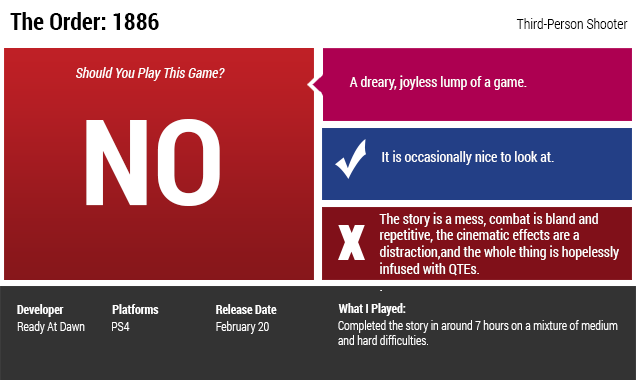You are using an out of date browser. It may not display this or other websites correctly.
You should upgrade or use an alternative browser.
You should upgrade or use an alternative browser.
The Order 1886 [FEB 20 PS4] (Metacritic: 65)
- Thread starter Rain
- Start date
More options
Who Replied?Damn 
It really that bad?
Such a predictable narrative though. You could already feel the general consensus brewing. Just my gut tells me it ain't that bad.
Ryse and Driveclub weren't as bad as they said

It really that bad?

Such a predictable narrative though. You could already feel the general consensus brewing. Just my gut tells me it ain't that bad.
Ryse and Driveclub weren't as bad as they said

 I honestly did not expect this. shyt is getting Knack scores. It cant be that bad can it? Anyway, eat well@MeachTheMonster and co
I honestly did not expect this. shyt is getting Knack scores. It cant be that bad can it? Anyway, eat well@MeachTheMonster and coKotaku


Show me the receipt @Rekkapryde
@Fatboi1 hiiiiiiiii
@Deezay take your L byotch
@PS4 we did it
Kingshango
Veteran

http://www.videogamer.com/reviews/the_order_1886_review.html
Ready at Dawn, finished by the afternoon.
 But
But  Ready at Dawn taking a L for this.
Ready at Dawn taking a L for this.Dragonfly Jones
Siiiiiiiilence Punk!!
Salty fanboy tears will be shed over another disappointing console exclusive. Still buying it. I eagerly await the fanboy spin and damage control though. The second coming of Ryse.
Ryse wasn't bad imo
It had it's issues but it was far from terrible
Beyond Two Souls, Resident Evil 6, Heavy Rain, Ryse etc all got low to mixed ratings from publications and all ended up being games I enjoyed thoroughly
I'm expecting this to be the same

Salty fanboy tears will be shed over another disappointing console exclusive. Still buying it. I eagerly await the fanboy spin and damage control though. The second coming of Ryse.
Ryse came out a year and a half ago and was still better than this shyt
Sounds like it's a fairly amazing experience that just doesn't have enough shooting gameplay, which honestly is alright with me I'm more an immersion gamer, trying to get lost in an amazingly crafted world.
It seems that the gameplay itself is basically serviceable when it does happen as well. Which kinda sucks, but not a game breaker for me.
I may cop just for the immersion and as a graphics show off.
Sony coulda delayed another year and gotten game-play in 'Order' I'd bet, but then everyone would say there is no games so
No, buying a game for graphics is not a problem, it's my PS4
It seems that the gameplay itself is basically serviceable when it does happen as well. Which kinda sucks, but not a game breaker for me.
I may cop just for the immersion and as a graphics show off.
Sony coulda delayed another year and gotten game-play in 'Order' I'd bet, but then everyone would say there is no games so

No, buying a game for graphics is not a problem, it's my PS4

Dragonfly Jones
Siiiiiiiilence Punk!!
This review seems pretty honest, pointing out its flaws while also acknowledging what it does best. Overall he recommends you buy it
Ryse came out a year and a half ago and was still better than this shyt
nikkas waited a year in a half for the "launch game graphics showcase" game.

#4TheWaiters: The famine continues

What you taggin me for?

I already said I'm coppin tomorrow. I think for myself ole sheep ass nikka.

Jim Sterling almost convinced me not to buy here.Ryse wasn't bad imo
It had it's issues but it was far from terrible
Beyond Two Souls, Resident Evil 6, Heavy Rain, Ryse etc all got low to mixed ratings from publications and all ended up being games I enjoyed thoroughly
I'm expecting this to be the same

http://www.thejimquisition.com/2015/02/the-order-1886-review/The Order‘s real problem, however, isn’t that it’s short – it’s that it does so very little with the time it has. Narratively, the game is a prologue as opposed to a full-fledged story, concerned only with building to a crescendo that never comes. Just as things finally get interesting and the plot unfolds… the credits roll. In the final chapters of the game, we deal with revelations that would occur halfway through any complete story but are instead used here solely to set up a sequel, to the point where I’d say 1886 is nothing BUT one big teaser for a presumptuously pre-planned franchise.
Five hours of tight storytelling can be justified, but this is all just a big tease with no payoff. The whole thing comes off more like the first installment of an episodic series than a complete title in its own right, and I was shocked when the game ended as I genuinely thought I’d hit the halfway point and was about to start kicking things into high gear. Forgive the turn of phrase, but if any other game has given me a bigger case of the proverbial blue balls, I certainly cannot recall it.
“But… the game’s just started,” I stammered while The Order: 1886 told me it was all over. “Oh wait, here’s a new cutscene, maybe the credits were a red herr… oh… more credits.”

